Economics for Business: Analysis of Australian Economic Stability
VerifiedAdded on 2020/02/18
|11
|1530
|77
Report
AI Summary
This report delves into the economic concept of stable equilibrium, explaining it from both microeconomic and macroeconomic perspectives. It defines equilibrium as a market situation where demand and supply forces balance, and a stable equilibrium as one that, when disrupted by external factors, eventually returns to its original state. The report then analyzes the Australian economy, highlighting its capitalistic structure and market-based economic framework. It examines the country's GDP and inflation rates, demonstrating a trend of moderate stability. Furthermore, the report discusses the stabilizing policies employed by the Australian economy, including automatic stabilizers like tax receipts and discretionary stabilizers involving government budget adjustments. The conclusion affirms the overall stability of the Australian economy, supported by its policy framework and efficient stabilizers.
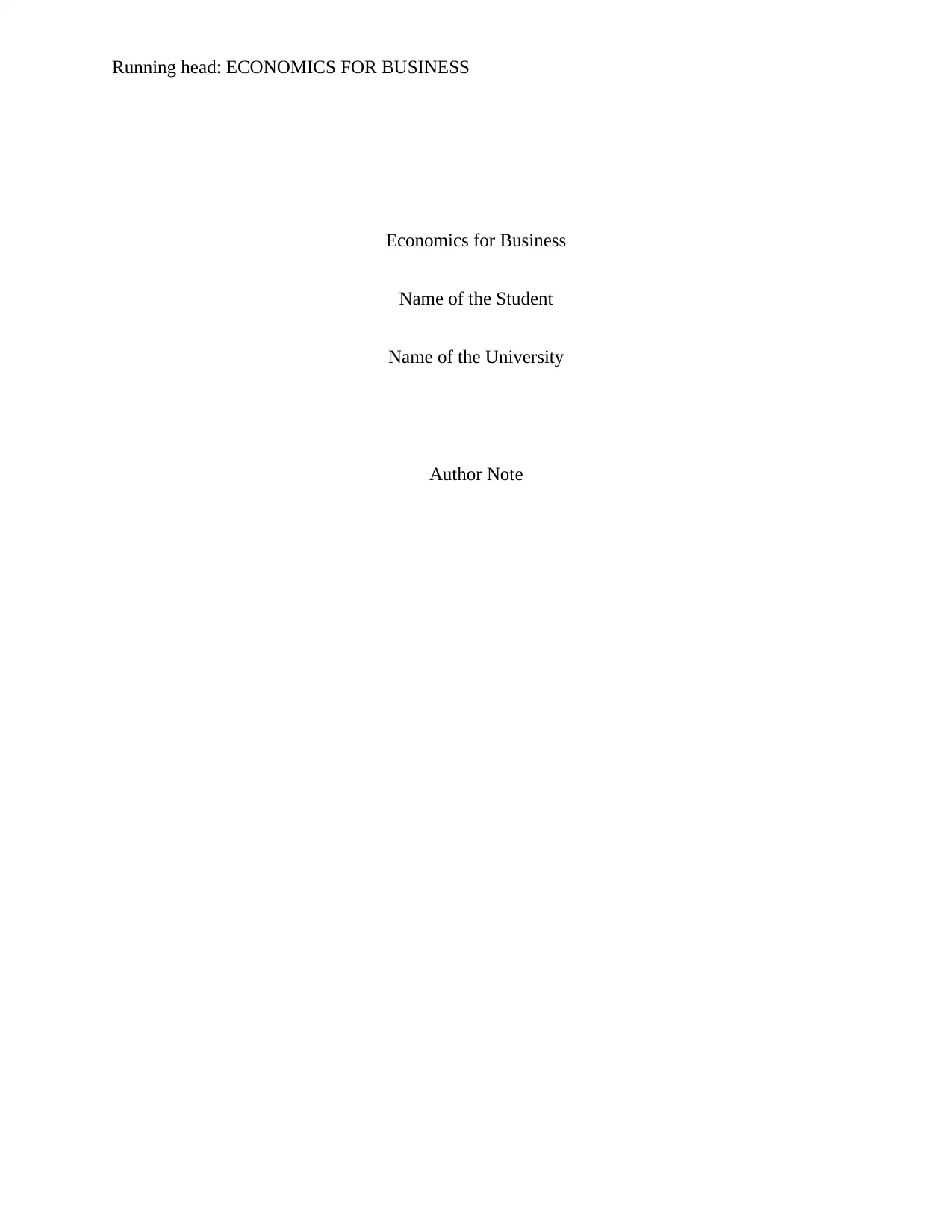
Running head: ECONOMICS FOR BUSINESS
Economics for Business
Name of the Student
Name of the University
Author Note
Economics for Business
Name of the Student
Name of the University
Author Note
Paraphrase This Document
Need a fresh take? Get an instant paraphrase of this document with our AI Paraphraser
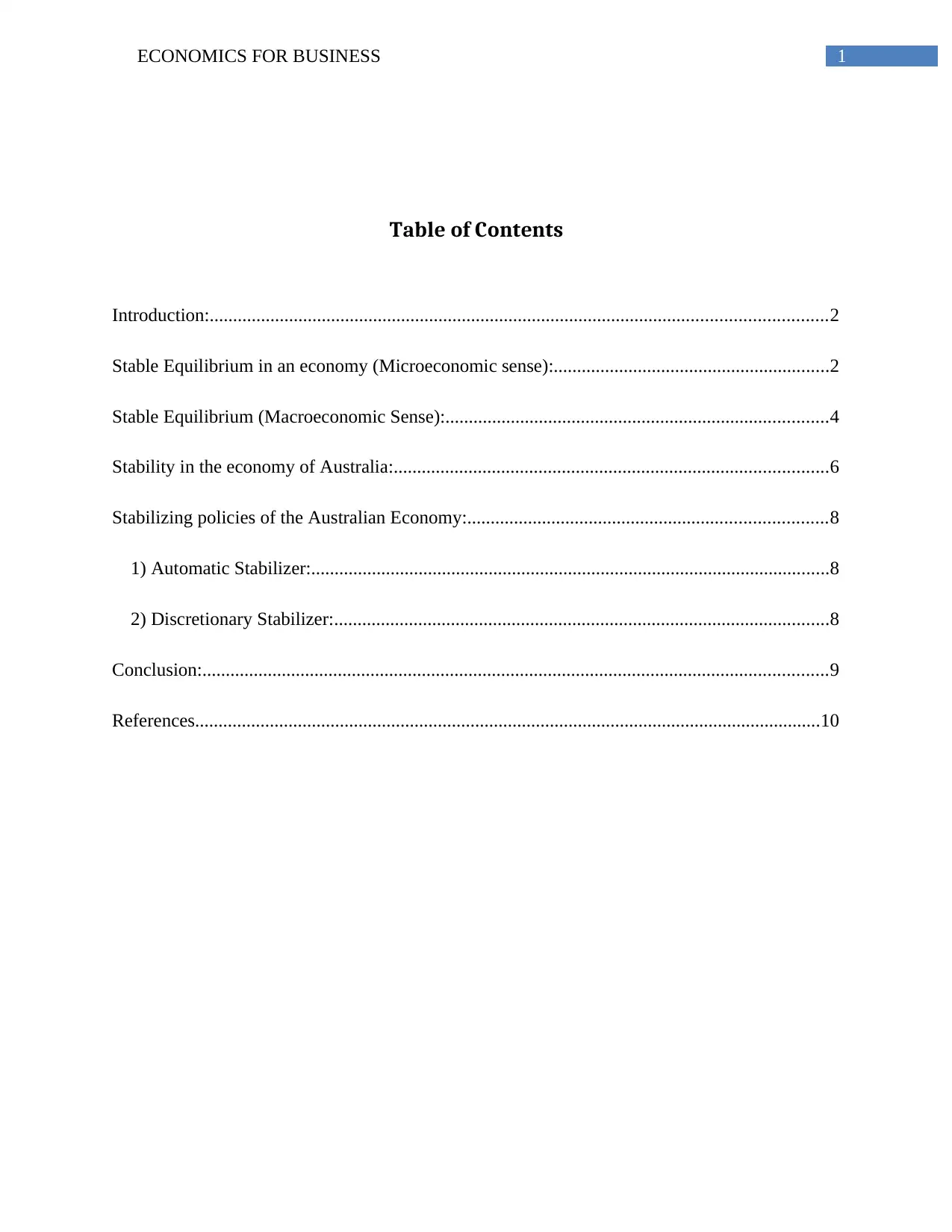
1ECONOMICS FOR BUSINESS
Table of Contents
Introduction:....................................................................................................................................2
Stable Equilibrium in an economy (Microeconomic sense):...........................................................2
Stable Equilibrium (Macroeconomic Sense):..................................................................................4
Stability in the economy of Australia:.............................................................................................6
Stabilizing policies of the Australian Economy:.............................................................................8
1) Automatic Stabilizer:...............................................................................................................8
2) Discretionary Stabilizer:..........................................................................................................8
Conclusion:......................................................................................................................................9
References......................................................................................................................................10
Table of Contents
Introduction:....................................................................................................................................2
Stable Equilibrium in an economy (Microeconomic sense):...........................................................2
Stable Equilibrium (Macroeconomic Sense):..................................................................................4
Stability in the economy of Australia:.............................................................................................6
Stabilizing policies of the Australian Economy:.............................................................................8
1) Automatic Stabilizer:...............................................................................................................8
2) Discretionary Stabilizer:..........................................................................................................8
Conclusion:......................................................................................................................................9
References......................................................................................................................................10
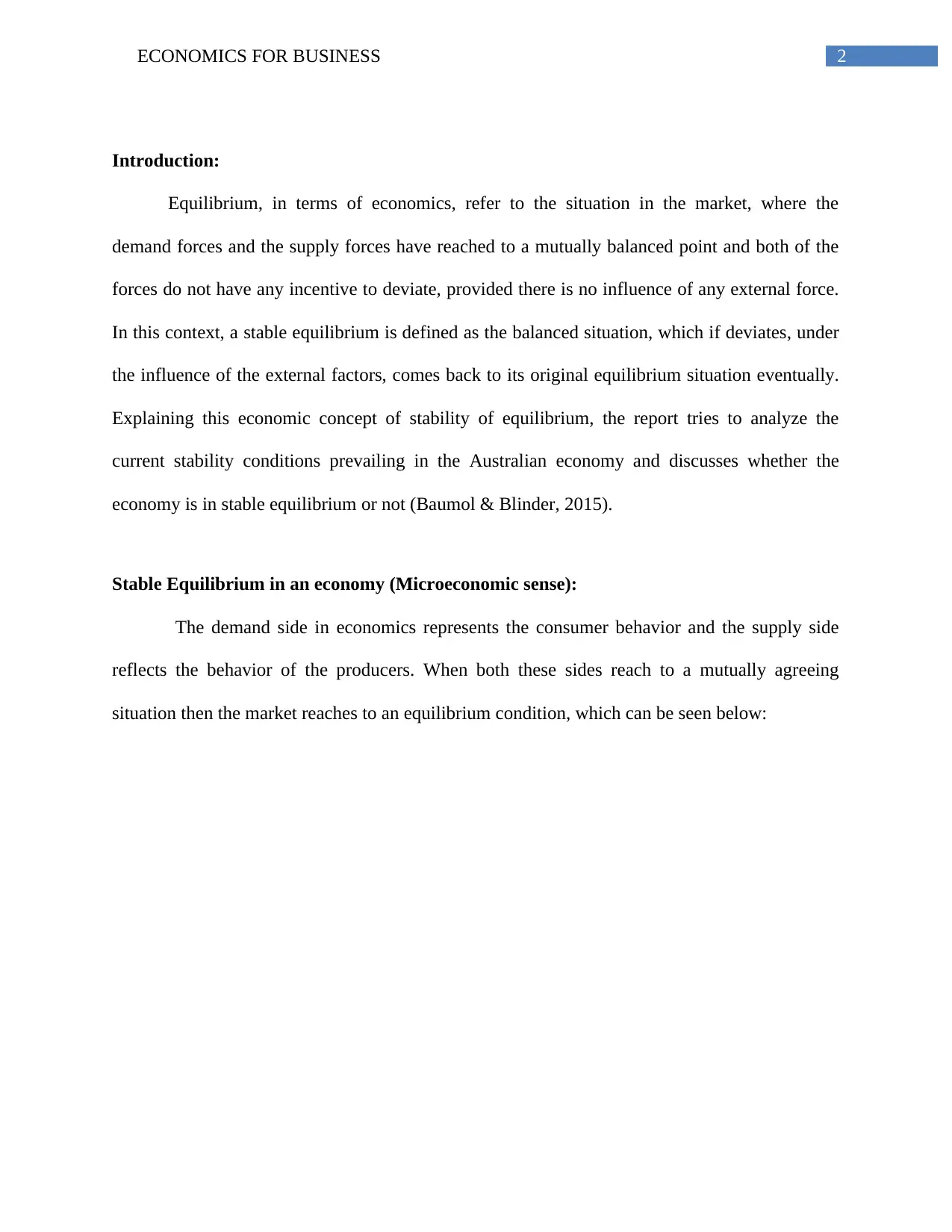
2ECONOMICS FOR BUSINESS
Introduction:
Equilibrium, in terms of economics, refer to the situation in the market, where the
demand forces and the supply forces have reached to a mutually balanced point and both of the
forces do not have any incentive to deviate, provided there is no influence of any external force.
In this context, a stable equilibrium is defined as the balanced situation, which if deviates, under
the influence of the external factors, comes back to its original equilibrium situation eventually.
Explaining this economic concept of stability of equilibrium, the report tries to analyze the
current stability conditions prevailing in the Australian economy and discusses whether the
economy is in stable equilibrium or not (Baumol & Blinder, 2015).
Stable Equilibrium in an economy (Microeconomic sense):
The demand side in economics represents the consumer behavior and the supply side
reflects the behavior of the producers. When both these sides reach to a mutually agreeing
situation then the market reaches to an equilibrium condition, which can be seen below:
Introduction:
Equilibrium, in terms of economics, refer to the situation in the market, where the
demand forces and the supply forces have reached to a mutually balanced point and both of the
forces do not have any incentive to deviate, provided there is no influence of any external force.
In this context, a stable equilibrium is defined as the balanced situation, which if deviates, under
the influence of the external factors, comes back to its original equilibrium situation eventually.
Explaining this economic concept of stability of equilibrium, the report tries to analyze the
current stability conditions prevailing in the Australian economy and discusses whether the
economy is in stable equilibrium or not (Baumol & Blinder, 2015).
Stable Equilibrium in an economy (Microeconomic sense):
The demand side in economics represents the consumer behavior and the supply side
reflects the behavior of the producers. When both these sides reach to a mutually agreeing
situation then the market reaches to an equilibrium condition, which can be seen below:
⊘ This is a preview!⊘
Do you want full access?
Subscribe today to unlock all pages.

Trusted by 1+ million students worldwide
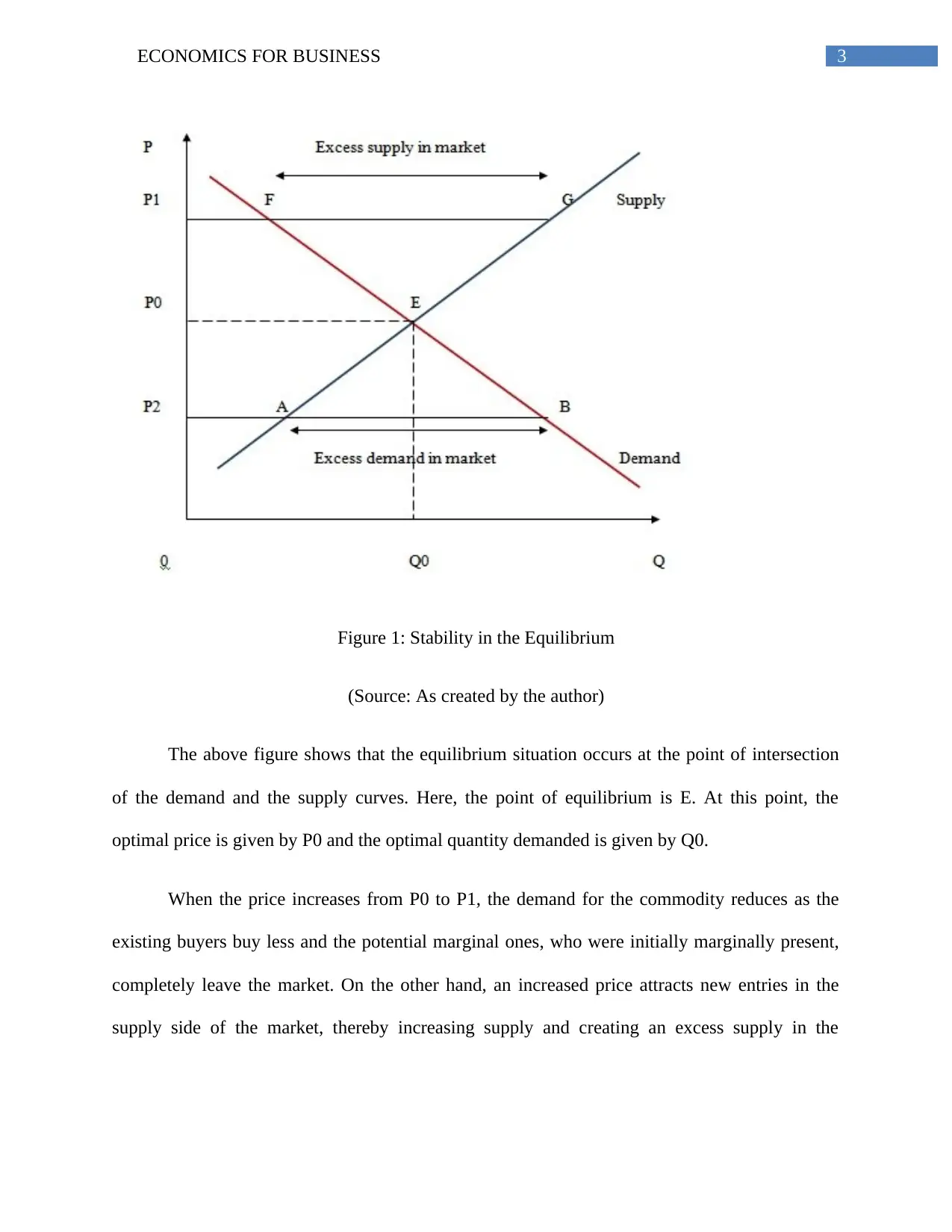
3ECONOMICS FOR BUSINESS
Figure 1: Stability in the Equilibrium
(Source: As created by the author)
The above figure shows that the equilibrium situation occurs at the point of intersection
of the demand and the supply curves. Here, the point of equilibrium is E. At this point, the
optimal price is given by P0 and the optimal quantity demanded is given by Q0.
When the price increases from P0 to P1, the demand for the commodity reduces as the
existing buyers buy less and the potential marginal ones, who were initially marginally present,
completely leave the market. On the other hand, an increased price attracts new entries in the
supply side of the market, thereby increasing supply and creating an excess supply in the
Figure 1: Stability in the Equilibrium
(Source: As created by the author)
The above figure shows that the equilibrium situation occurs at the point of intersection
of the demand and the supply curves. Here, the point of equilibrium is E. At this point, the
optimal price is given by P0 and the optimal quantity demanded is given by Q0.
When the price increases from P0 to P1, the demand for the commodity reduces as the
existing buyers buy less and the potential marginal ones, who were initially marginally present,
completely leave the market. On the other hand, an increased price attracts new entries in the
supply side of the market, thereby increasing supply and creating an excess supply in the
Paraphrase This Document
Need a fresh take? Get an instant paraphrase of this document with our AI Paraphraser
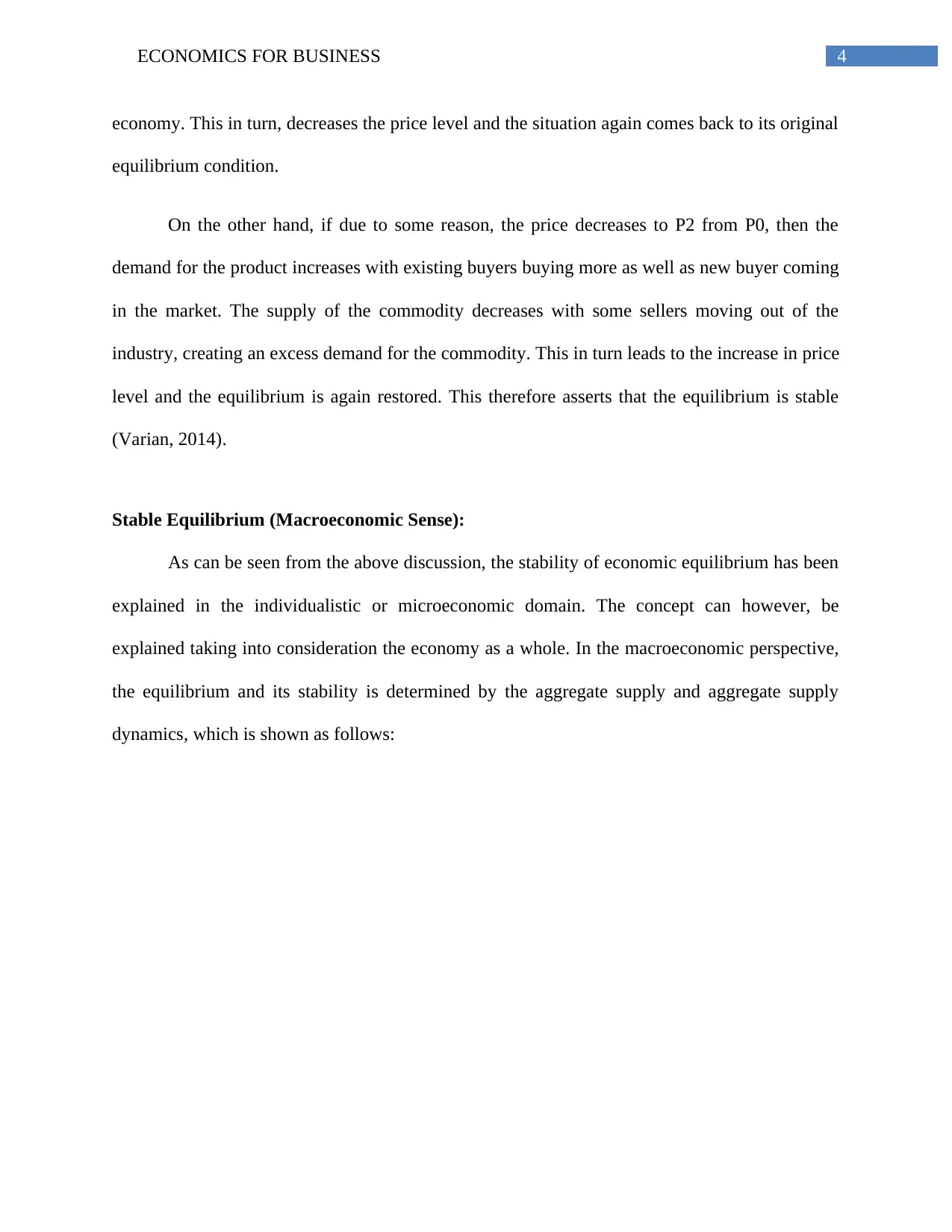
4ECONOMICS FOR BUSINESS
economy. This in turn, decreases the price level and the situation again comes back to its original
equilibrium condition.
On the other hand, if due to some reason, the price decreases to P2 from P0, then the
demand for the product increases with existing buyers buying more as well as new buyer coming
in the market. The supply of the commodity decreases with some sellers moving out of the
industry, creating an excess demand for the commodity. This in turn leads to the increase in price
level and the equilibrium is again restored. This therefore asserts that the equilibrium is stable
(Varian, 2014).
Stable Equilibrium (Macroeconomic Sense):
As can be seen from the above discussion, the stability of economic equilibrium has been
explained in the individualistic or microeconomic domain. The concept can however, be
explained taking into consideration the economy as a whole. In the macroeconomic perspective,
the equilibrium and its stability is determined by the aggregate supply and aggregate supply
dynamics, which is shown as follows:
economy. This in turn, decreases the price level and the situation again comes back to its original
equilibrium condition.
On the other hand, if due to some reason, the price decreases to P2 from P0, then the
demand for the product increases with existing buyers buying more as well as new buyer coming
in the market. The supply of the commodity decreases with some sellers moving out of the
industry, creating an excess demand for the commodity. This in turn leads to the increase in price
level and the equilibrium is again restored. This therefore asserts that the equilibrium is stable
(Varian, 2014).
Stable Equilibrium (Macroeconomic Sense):
As can be seen from the above discussion, the stability of economic equilibrium has been
explained in the individualistic or microeconomic domain. The concept can however, be
explained taking into consideration the economy as a whole. In the macroeconomic perspective,
the equilibrium and its stability is determined by the aggregate supply and aggregate supply
dynamics, which is shown as follows:
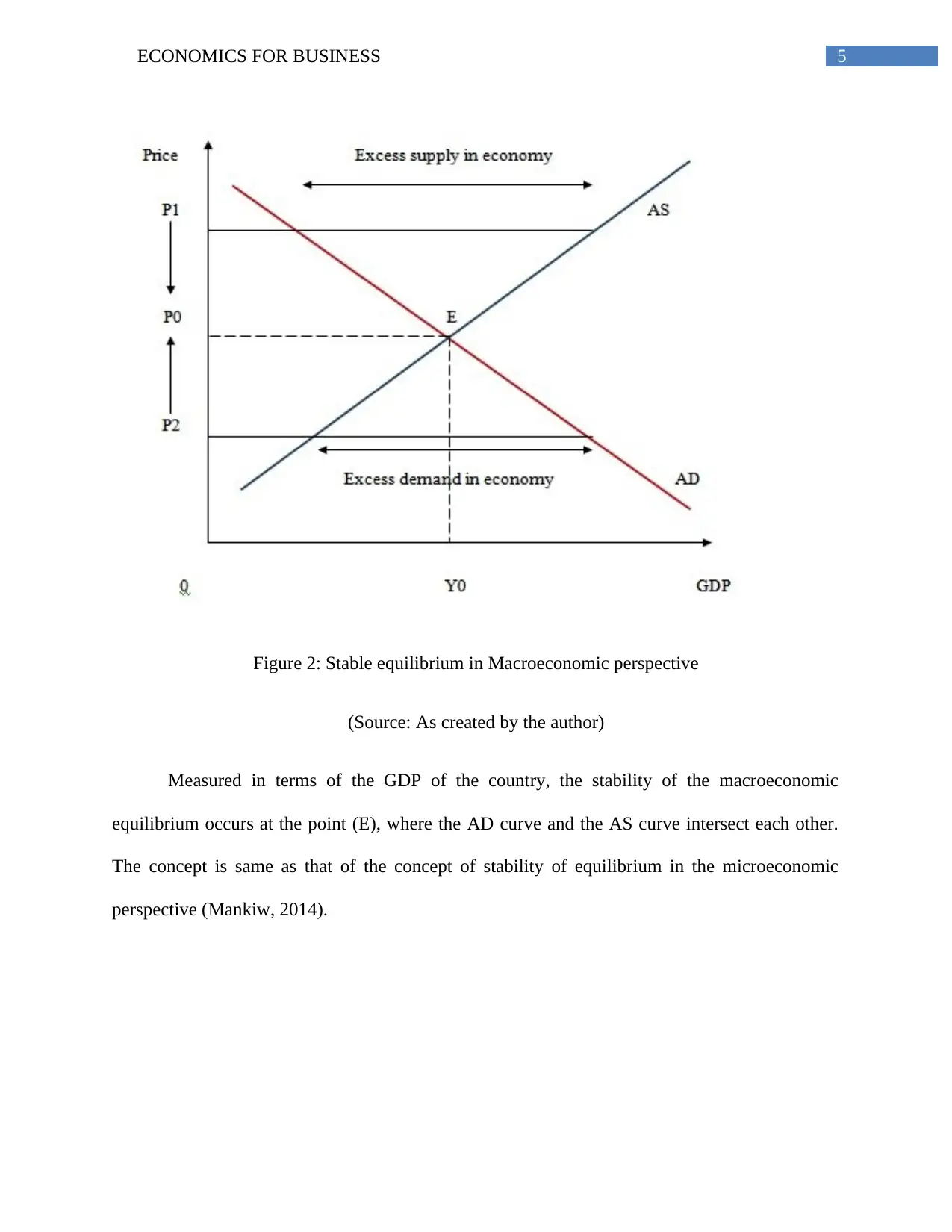
5ECONOMICS FOR BUSINESS
Figure 2: Stable equilibrium in Macroeconomic perspective
(Source: As created by the author)
Measured in terms of the GDP of the country, the stability of the macroeconomic
equilibrium occurs at the point (E), where the AD curve and the AS curve intersect each other.
The concept is same as that of the concept of stability of equilibrium in the microeconomic
perspective (Mankiw, 2014).
Figure 2: Stable equilibrium in Macroeconomic perspective
(Source: As created by the author)
Measured in terms of the GDP of the country, the stability of the macroeconomic
equilibrium occurs at the point (E), where the AD curve and the AS curve intersect each other.
The concept is same as that of the concept of stability of equilibrium in the microeconomic
perspective (Mankiw, 2014).
⊘ This is a preview!⊘
Do you want full access?
Subscribe today to unlock all pages.

Trusted by 1+ million students worldwide
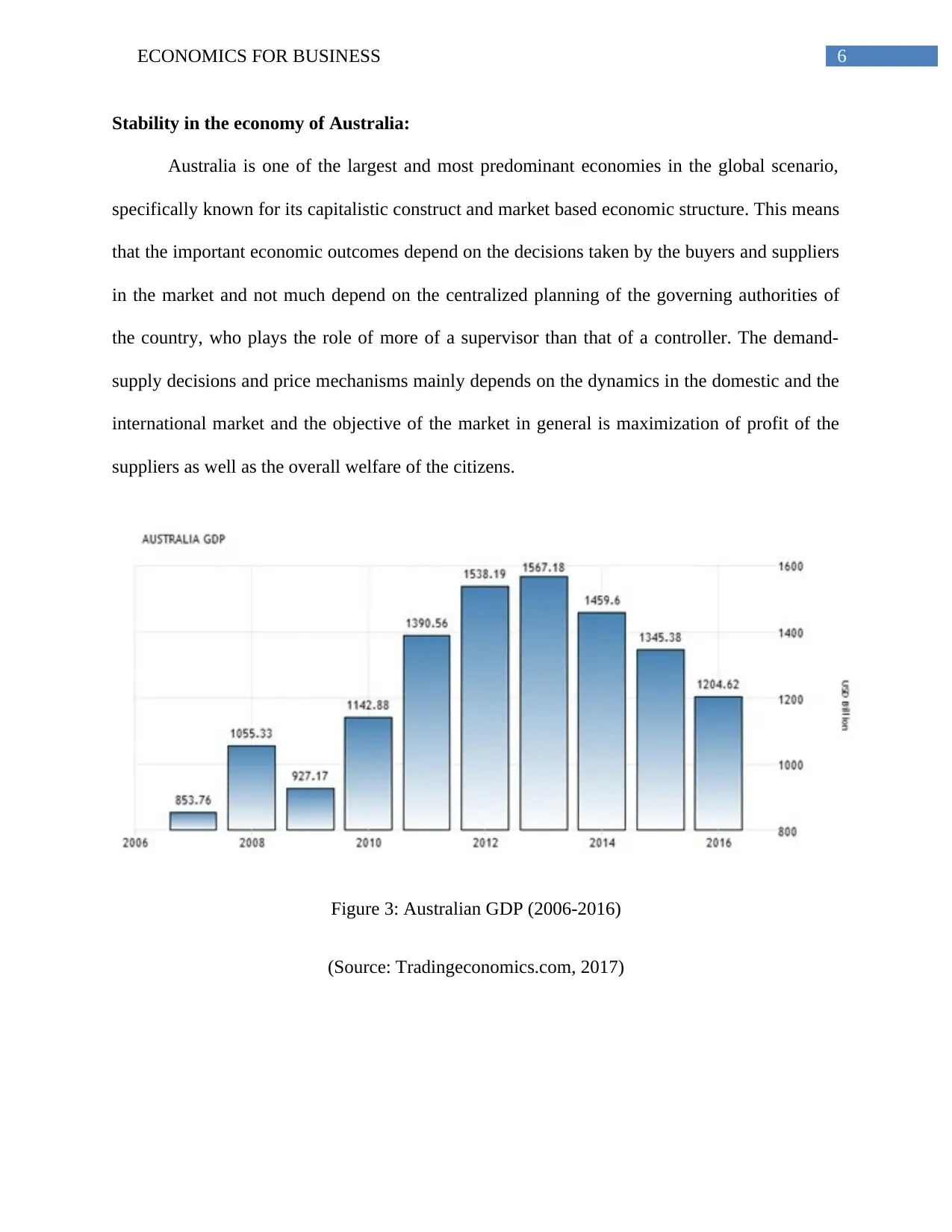
6ECONOMICS FOR BUSINESS
Stability in the economy of Australia:
Australia is one of the largest and most predominant economies in the global scenario,
specifically known for its capitalistic construct and market based economic structure. This means
that the important economic outcomes depend on the decisions taken by the buyers and suppliers
in the market and not much depend on the centralized planning of the governing authorities of
the country, who plays the role of more of a supervisor than that of a controller. The demand-
supply decisions and price mechanisms mainly depends on the dynamics in the domestic and the
international market and the objective of the market in general is maximization of profit of the
suppliers as well as the overall welfare of the citizens.
Figure 3: Australian GDP (2006-2016)
(Source: Tradingeconomics.com, 2017)
Stability in the economy of Australia:
Australia is one of the largest and most predominant economies in the global scenario,
specifically known for its capitalistic construct and market based economic structure. This means
that the important economic outcomes depend on the decisions taken by the buyers and suppliers
in the market and not much depend on the centralized planning of the governing authorities of
the country, who plays the role of more of a supervisor than that of a controller. The demand-
supply decisions and price mechanisms mainly depends on the dynamics in the domestic and the
international market and the objective of the market in general is maximization of profit of the
suppliers as well as the overall welfare of the citizens.
Figure 3: Australian GDP (2006-2016)
(Source: Tradingeconomics.com, 2017)
Paraphrase This Document
Need a fresh take? Get an instant paraphrase of this document with our AI Paraphraser
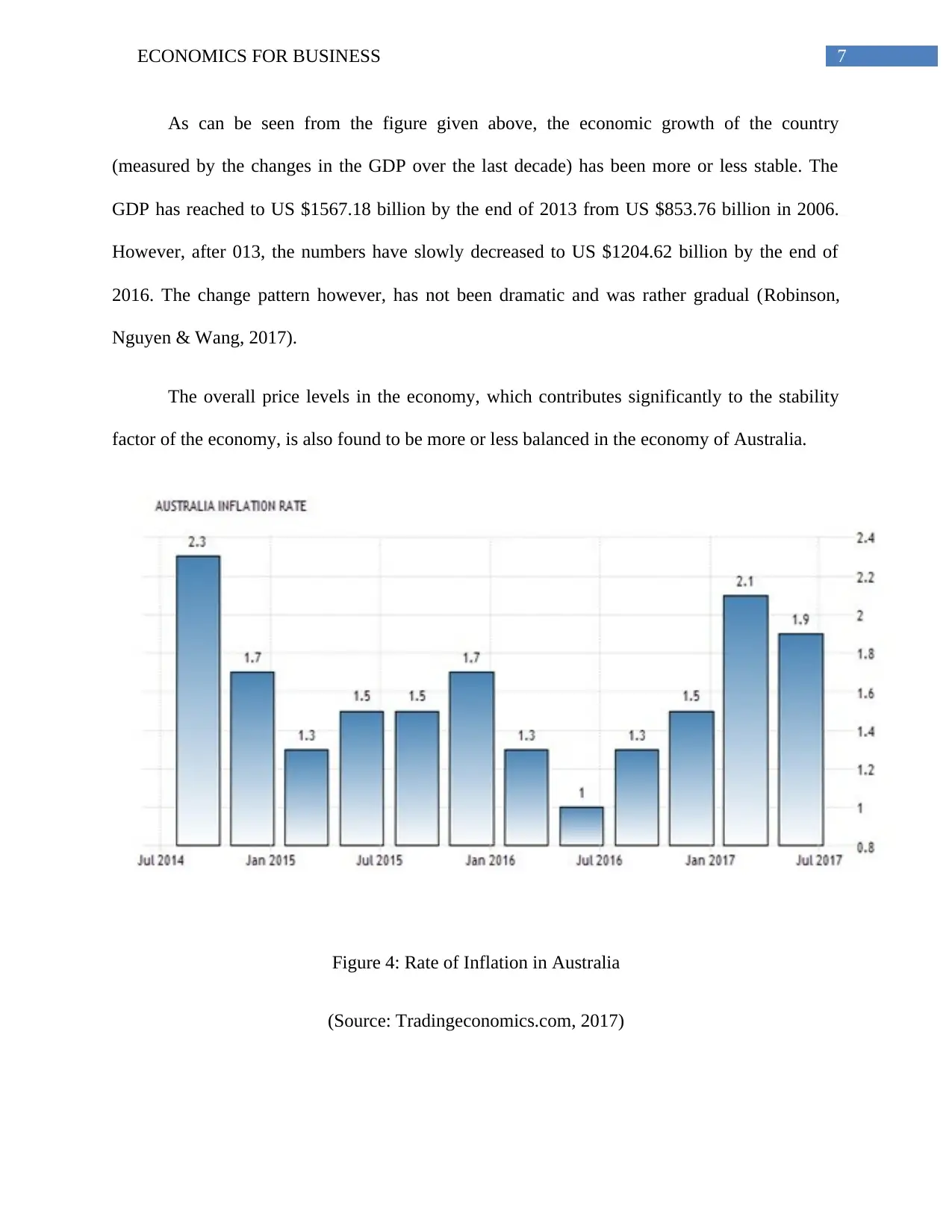
7ECONOMICS FOR BUSINESS
As can be seen from the figure given above, the economic growth of the country
(measured by the changes in the GDP over the last decade) has been more or less stable. The
GDP has reached to US $1567.18 billion by the end of 2013 from US $853.76 billion in 2006.
However, after 013, the numbers have slowly decreased to US $1204.62 billion by the end of
2016. The change pattern however, has not been dramatic and was rather gradual (Robinson,
Nguyen & Wang, 2017).
The overall price levels in the economy, which contributes significantly to the stability
factor of the economy, is also found to be more or less balanced in the economy of Australia.
Figure 4: Rate of Inflation in Australia
(Source: Tradingeconomics.com, 2017)
As can be seen from the figure given above, the economic growth of the country
(measured by the changes in the GDP over the last decade) has been more or less stable. The
GDP has reached to US $1567.18 billion by the end of 2013 from US $853.76 billion in 2006.
However, after 013, the numbers have slowly decreased to US $1204.62 billion by the end of
2016. The change pattern however, has not been dramatic and was rather gradual (Robinson,
Nguyen & Wang, 2017).
The overall price levels in the economy, which contributes significantly to the stability
factor of the economy, is also found to be more or less balanced in the economy of Australia.
Figure 4: Rate of Inflation in Australia
(Source: Tradingeconomics.com, 2017)
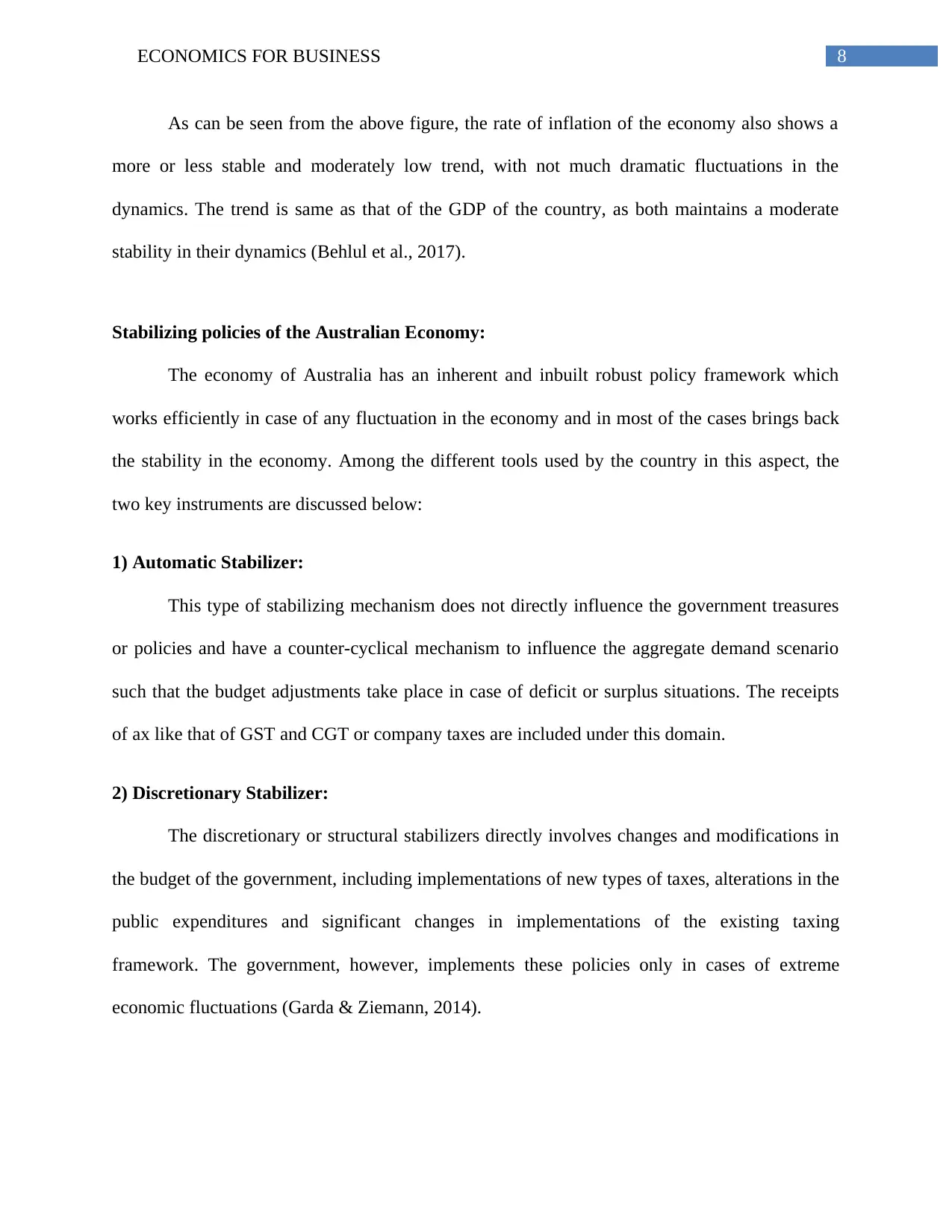
8ECONOMICS FOR BUSINESS
As can be seen from the above figure, the rate of inflation of the economy also shows a
more or less stable and moderately low trend, with not much dramatic fluctuations in the
dynamics. The trend is same as that of the GDP of the country, as both maintains a moderate
stability in their dynamics (Behlul et al., 2017).
Stabilizing policies of the Australian Economy:
The economy of Australia has an inherent and inbuilt robust policy framework which
works efficiently in case of any fluctuation in the economy and in most of the cases brings back
the stability in the economy. Among the different tools used by the country in this aspect, the
two key instruments are discussed below:
1) Automatic Stabilizer:
This type of stabilizing mechanism does not directly influence the government treasures
or policies and have a counter-cyclical mechanism to influence the aggregate demand scenario
such that the budget adjustments take place in case of deficit or surplus situations. The receipts
of ax like that of GST and CGT or company taxes are included under this domain.
2) Discretionary Stabilizer:
The discretionary or structural stabilizers directly involves changes and modifications in
the budget of the government, including implementations of new types of taxes, alterations in the
public expenditures and significant changes in implementations of the existing taxing
framework. The government, however, implements these policies only in cases of extreme
economic fluctuations (Garda & Ziemann, 2014).
As can be seen from the above figure, the rate of inflation of the economy also shows a
more or less stable and moderately low trend, with not much dramatic fluctuations in the
dynamics. The trend is same as that of the GDP of the country, as both maintains a moderate
stability in their dynamics (Behlul et al., 2017).
Stabilizing policies of the Australian Economy:
The economy of Australia has an inherent and inbuilt robust policy framework which
works efficiently in case of any fluctuation in the economy and in most of the cases brings back
the stability in the economy. Among the different tools used by the country in this aspect, the
two key instruments are discussed below:
1) Automatic Stabilizer:
This type of stabilizing mechanism does not directly influence the government treasures
or policies and have a counter-cyclical mechanism to influence the aggregate demand scenario
such that the budget adjustments take place in case of deficit or surplus situations. The receipts
of ax like that of GST and CGT or company taxes are included under this domain.
2) Discretionary Stabilizer:
The discretionary or structural stabilizers directly involves changes and modifications in
the budget of the government, including implementations of new types of taxes, alterations in the
public expenditures and significant changes in implementations of the existing taxing
framework. The government, however, implements these policies only in cases of extreme
economic fluctuations (Garda & Ziemann, 2014).
⊘ This is a preview!⊘
Do you want full access?
Subscribe today to unlock all pages.

Trusted by 1+ million students worldwide
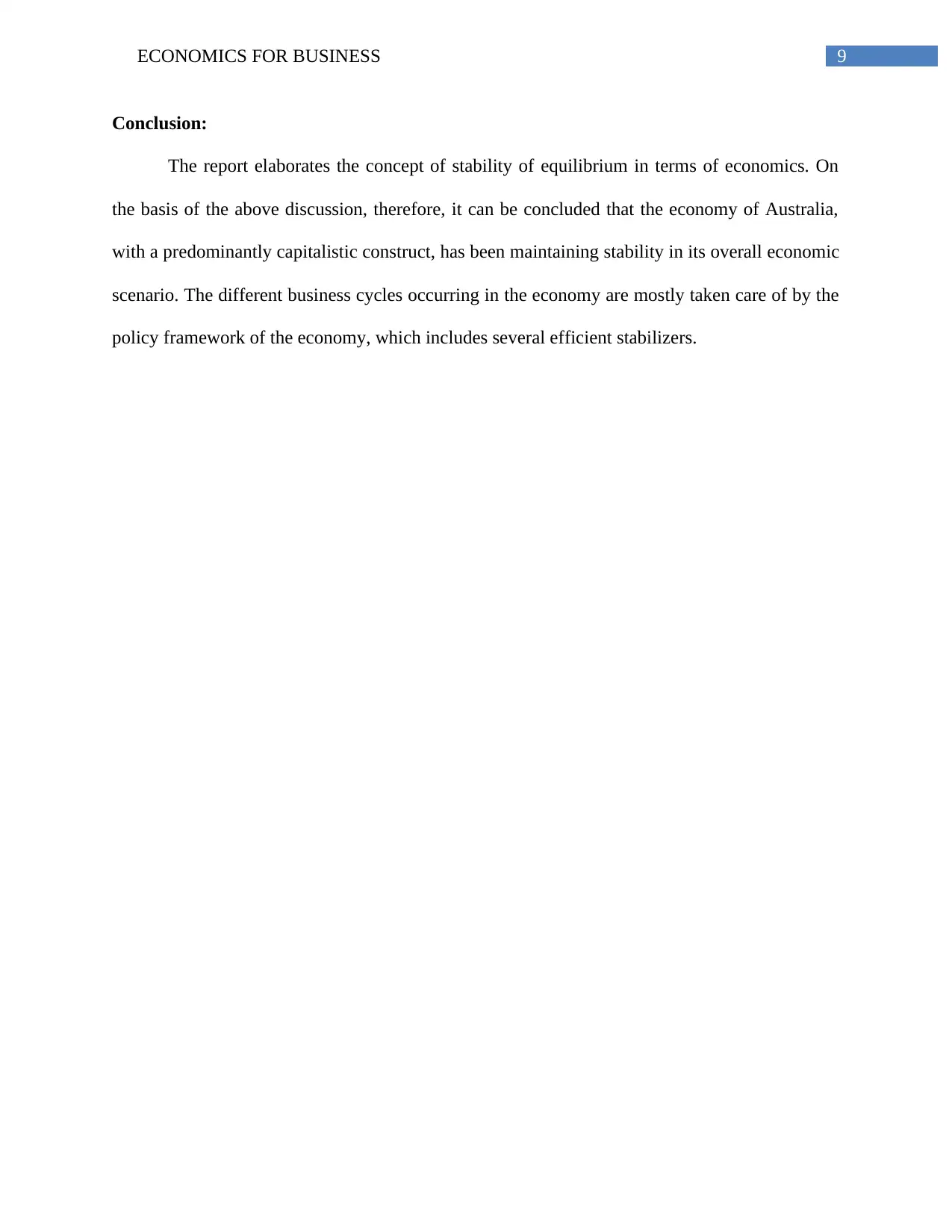
9ECONOMICS FOR BUSINESS
Conclusion:
The report elaborates the concept of stability of equilibrium in terms of economics. On
the basis of the above discussion, therefore, it can be concluded that the economy of Australia,
with a predominantly capitalistic construct, has been maintaining stability in its overall economic
scenario. The different business cycles occurring in the economy are mostly taken care of by the
policy framework of the economy, which includes several efficient stabilizers.
Conclusion:
The report elaborates the concept of stability of equilibrium in terms of economics. On
the basis of the above discussion, therefore, it can be concluded that the economy of Australia,
with a predominantly capitalistic construct, has been maintaining stability in its overall economic
scenario. The different business cycles occurring in the economy are mostly taken care of by the
policy framework of the economy, which includes several efficient stabilizers.
Paraphrase This Document
Need a fresh take? Get an instant paraphrase of this document with our AI Paraphraser
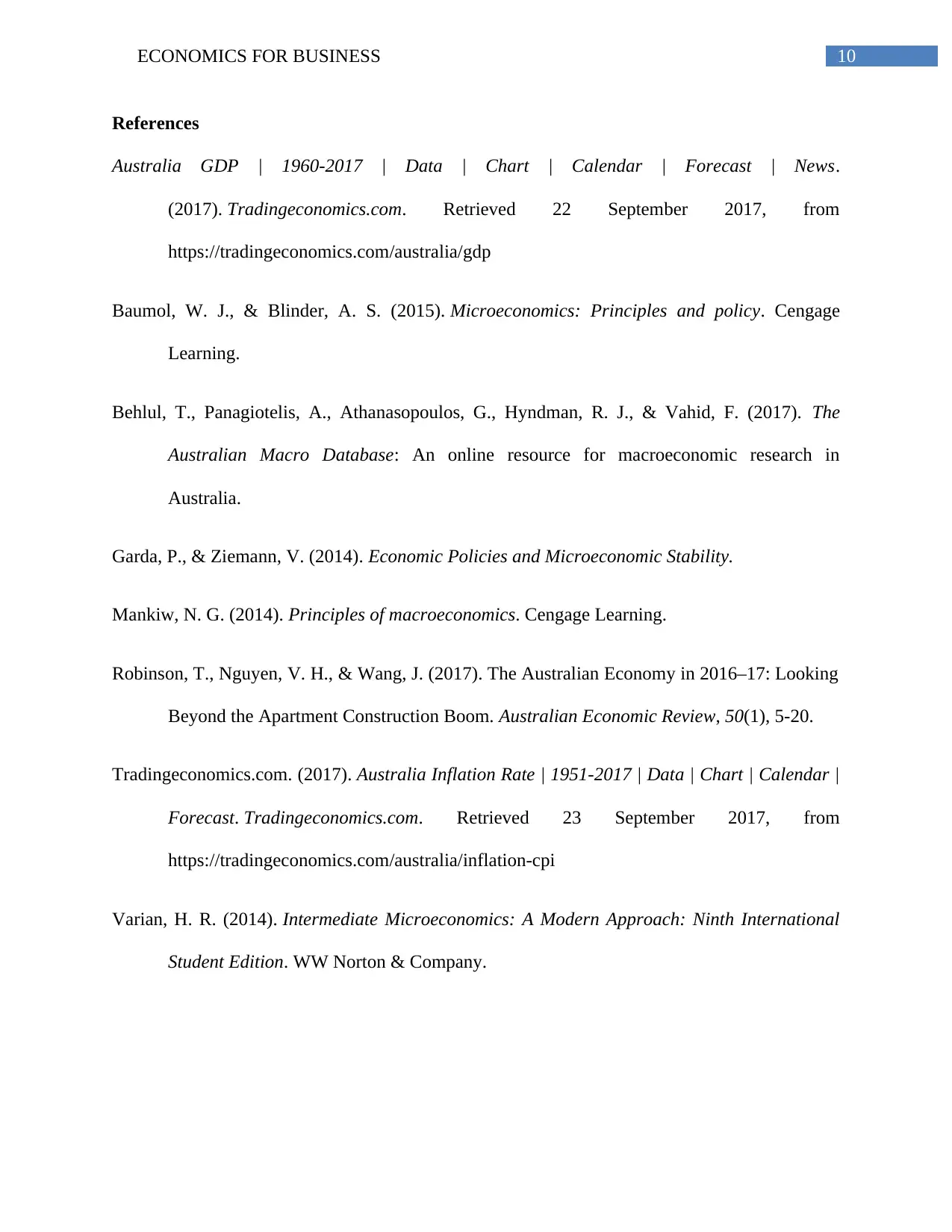
10ECONOMICS FOR BUSINESS
References
Australia GDP | 1960-2017 | Data | Chart | Calendar | Forecast | News.
(2017). Tradingeconomics.com. Retrieved 22 September 2017, from
https://tradingeconomics.com/australia/gdp
Baumol, W. J., & Blinder, A. S. (2015). Microeconomics: Principles and policy. Cengage
Learning.
Behlul, T., Panagiotelis, A., Athanasopoulos, G., Hyndman, R. J., & Vahid, F. (2017). The
Australian Macro Database: An online resource for macroeconomic research in
Australia.
Garda, P., & Ziemann, V. (2014). Economic Policies and Microeconomic Stability.
Mankiw, N. G. (2014). Principles of macroeconomics. Cengage Learning.
Robinson, T., Nguyen, V. H., & Wang, J. (2017). The Australian Economy in 2016–17: Looking
Beyond the Apartment Construction Boom. Australian Economic Review, 50(1), 5-20.
Tradingeconomics.com. (2017). Australia Inflation Rate | 1951-2017 | Data | Chart | Calendar |
Forecast. Tradingeconomics.com. Retrieved 23 September 2017, from
https://tradingeconomics.com/australia/inflation-cpi
Varian, H. R. (2014). Intermediate Microeconomics: A Modern Approach: Ninth International
Student Edition. WW Norton & Company.
References
Australia GDP | 1960-2017 | Data | Chart | Calendar | Forecast | News.
(2017). Tradingeconomics.com. Retrieved 22 September 2017, from
https://tradingeconomics.com/australia/gdp
Baumol, W. J., & Blinder, A. S. (2015). Microeconomics: Principles and policy. Cengage
Learning.
Behlul, T., Panagiotelis, A., Athanasopoulos, G., Hyndman, R. J., & Vahid, F. (2017). The
Australian Macro Database: An online resource for macroeconomic research in
Australia.
Garda, P., & Ziemann, V. (2014). Economic Policies and Microeconomic Stability.
Mankiw, N. G. (2014). Principles of macroeconomics. Cengage Learning.
Robinson, T., Nguyen, V. H., & Wang, J. (2017). The Australian Economy in 2016–17: Looking
Beyond the Apartment Construction Boom. Australian Economic Review, 50(1), 5-20.
Tradingeconomics.com. (2017). Australia Inflation Rate | 1951-2017 | Data | Chart | Calendar |
Forecast. Tradingeconomics.com. Retrieved 23 September 2017, from
https://tradingeconomics.com/australia/inflation-cpi
Varian, H. R. (2014). Intermediate Microeconomics: A Modern Approach: Ninth International
Student Edition. WW Norton & Company.
1 out of 11
Related Documents
Your All-in-One AI-Powered Toolkit for Academic Success.
+13062052269
info@desklib.com
Available 24*7 on WhatsApp / Email
![[object Object]](/_next/static/media/star-bottom.7253800d.svg)
Unlock your academic potential
Copyright © 2020–2025 A2Z Services. All Rights Reserved. Developed and managed by ZUCOL.





